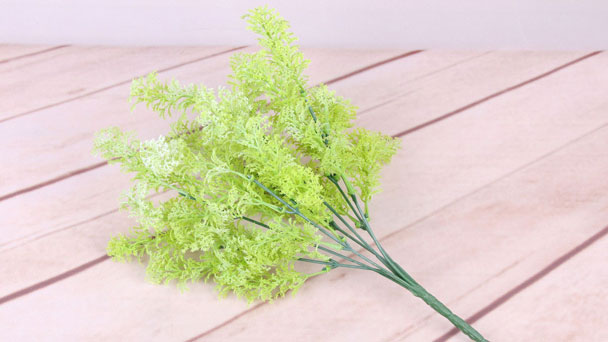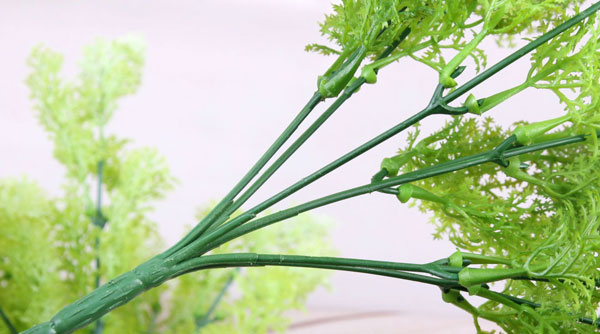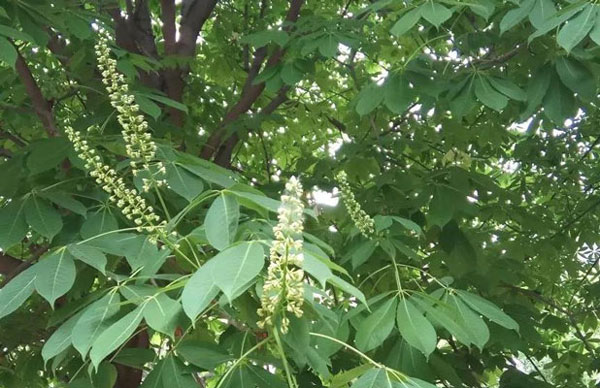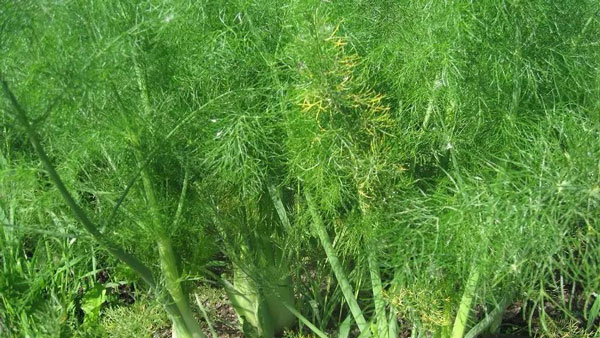Fennel: Grow & Care for Foeniculum vulgare
Written by Iris
Aug 03 2021

Fennel (Foeniculum vulgare) is an aromatic Mediterranean herb of the umbelliferaceae amily, which includes carrot, celery, dill, and parsley. Fennel's (Foeniculum vulgare) Edible yellow flowers, seeds, feathery leaves, pollen, roots and stems have long been prized for their intense, anise-like fragrance and flavor, and they are used as ingredients in cooking, magic potions and traditional medicine. Fennel (Foeniculum vulgare) is a prolific self-sower, so much so that common varieties have been naturalized to invasive sites throughout California and the west. If you plant the common type, you can prevent the spread of the flower heads by removing them before they begin to seed. This article explains how to grow and harvest these two common fennel seeds in your garden.
Soil should be well-drained and preferably fertile, particularly if you are growing fennel for the bulbs. Make sure you add any amendments, like compost or fertilizer, before planting.
Keep in mind that herb fennel can grow very tall (up to 5 feet), so plant it where it won’t shade anything else out.
Fennel grows the best if given its own space to occupy and placed in full sun. Afternoon shade can be helpful if you live in a hot climate, but otherwise, give plants lots of sun.
Also, certain compounds in the plants can inhibit the growth of other crops, especially tomatoes and beans. It might be a good idea to simply give fennel its own spot in your garden.

Start your seeds about 8 weeks before your last average frost date in the spring. Florence fennel can also be planted in late summer for a fall harvest, so you can start seeds 6-8 weeks before your planned planting date.
Here's what you'll need:
Then, fill up your trays with the dampened mix. Level off the top with your hand, and make sure there aren’t any air pockets in the soil.
If you are planting herb fennel, 2-3 full size plants will produce more than enough foliage and seeds for a whole family. Unless you want to harvest very large amounts, stick with just a few plants.
Plant your seeds ¼ inch deep into your trays. Make sure they are covered with a light layer of soil and water them in well.
If you have plastic covers, put them on your trays now to help keep the soil mix moist while the seeds germinate. Place the trays somewhere warm and out of the way. The seeds should germinate in 8-12 days.
Once your seeds sprout, remove the plastic covers and place the trays under grow lights or by a very sunny window. Keep your seedlings water, but don’t oversaturate the soil.
You may find that rabbits take quite an interest in your plants, but deer and groundhogs don’t seem to care for its aroma.
Some pests to be aware of are:
In addition, there are a few diseases that may present themselves, including:
'Solaris' produces large semi-flat bulbs that are resistant to bolting.
'Zefa fino' is ready for harvest in 80 days, bolt resistant, and very large.
'Orion' is ready to harvest in 80 days and has large, thick, rounded bulbs with a crisp texture.
Herb fennel (Foeniculum vulgare) is the type to plant if you will use the plant strictly as an herb. There are two common varieties:
Green (Foeniculum vulgare 'Dulce')
Red (Foeniculum vulgare 'Rubrum')
How to Choose and Prepare a Planting SiteWhen to Grow Fennel (Foeniculum vulgare)How to Grow Fennel (Foeniculum vulgare)How to Care for Fennel (Foeniculum vulgare)Varieties of Fennel (Foeniculum vulgare)Fennel (Foeniculum vulgare) FAQ
How to Choose and Prepare a Planting Site
Both types of fennel prefer a full sun location, although they will tolerate partial shade, especially in hotter areas.Soil should be well-drained and preferably fertile, particularly if you are growing fennel for the bulbs. Make sure you add any amendments, like compost or fertilizer, before planting.
Keep in mind that herb fennel can grow very tall (up to 5 feet), so plant it where it won’t shade anything else out.
Fennel grows the best if given its own space to occupy and placed in full sun. Afternoon shade can be helpful if you live in a hot climate, but otherwise, give plants lots of sun.
Also, certain compounds in the plants can inhibit the growth of other crops, especially tomatoes and beans. It might be a good idea to simply give fennel its own spot in your garden.
When to Grow Fennel (Foeniculum vulgare)
One of the reasons to sow bulb fennel at midsummer is its love of sunny conditions. Hailing from the Mediterranean, it is at home in a fertile yet free-drained soil that's lovingly basked by the warming rays of summer. While those in Mediterranean-equivalent zones can of course sow in spring, those at more northerly latitudes must bide their time to be sure of success. By midsummer the soil will have warmed up more than adequately and success will be all but assured.
How to Grow Fennel (Foeniculum vulgare)
Steps for Fennel (Foeniculum vulgare) Propagation with Seeds
Both types of fennel can be grown from seed, and this is the most reliable method to use (unless you want to buy plants from a nursery). You can start them outdoors directly in your garden or pots, or you can give them a headstart indoors.Start your seeds about 8 weeks before your last average frost date in the spring. Florence fennel can also be planted in late summer for a fall harvest, so you can start seeds 6-8 weeks before your planned planting date.
Here's what you'll need:
- Fennel seeds
- Seed starting trays
- Seed starting medium
- Plastic covers (optional)
- Grow lights (optional but preferred)
- Water
Then, fill up your trays with the dampened mix. Level off the top with your hand, and make sure there aren’t any air pockets in the soil.
If you are planting herb fennel, 2-3 full size plants will produce more than enough foliage and seeds for a whole family. Unless you want to harvest very large amounts, stick with just a few plants.
Plant your seeds ¼ inch deep into your trays. Make sure they are covered with a light layer of soil and water them in well.
If you have plastic covers, put them on your trays now to help keep the soil mix moist while the seeds germinate. Place the trays somewhere warm and out of the way. The seeds should germinate in 8-12 days.
Once your seeds sprout, remove the plastic covers and place the trays under grow lights or by a very sunny window. Keep your seedlings water, but don’t oversaturate the soil.
Steps for Fennel (Foeniculum vulgare) Propagation with Division
Mature common fennel plants may be propagated by division with varied success due to problems with disturbing its taproot. Plants may be dug up in spring when shoots begin to appear. When removing the plant ensure the entire root system remains intact. Viable side shoots can be removed from the main crown and potted into a sandy compost mix and grown in pots until new roots have established. Once roots have filled the pot, plant into a new growing position.
How to Care for Fennel (Foeniculum vulgare)
Light
This plant prefers full sunlight. Shady conditions will make it leggy and floppy. A minimum of six hours of sun is needed.Soil
Plant fennel in moist, fertile, well-drained soil. It prefers acidic soil (pH 5.5 to 6.8). Amending the soil with plenty of aged compost is standard practice.Water
Be sure to keep soil consistently moist. Water regularly, giving plants at least an inch of water per week (more in hot weather). Stick your finger into the soil to check moisture; if the top inch is dry, it’s time to water.Temperature and Humidity
They grow best in USDA zones 6-10 with ideal temperatures ranging from 60-70ºF (15-21ºC). As a perennial, common fennel will overwinter outside, but may not survive prolonged freezing temperatures. Summer sown bulb fennel can be harvested right up until the first frosts. In milder climates, it can be overwintered and treated as a biennial for seed production. Plants benefit from mulches to retain moisture in summer and heat in winter.Fertilizer
Apply lots of well-rotted organic matter such as farm-yard manure or compost to the planting site at least six weeks before planting. A balanced slow-release fertilizer can be added to the seedbed prior to planting as an extra boost. When bulbs begin to swell apply a nitrogen-rich liquid fertilizer once every two weeks until harvest. Mulch herb fennel in springtime for added nutrition.Pruning
Stems of common fennel can be pruned back to ground level after seeds are harvested. Fennel plants that are grown for ornamental use often retain the dried seed heads to provide winter structure in the garden. This can result in self-seeded plants popping up around the garden in spring, but these are easily weeded out. Prune any developing bulb fennel flower spikes to stop them from bolting.Pests and Diseases
When you start with quality seed, cultivate during cool weather, provide rich soil that drains well, don’t overwater, and keep the garden free of weeds, pests and disease issues should be minimal. However, sometimes even with the best intentions, we have to contend with herbivores, insect pests, and diseases often borne by these pests.You may find that rabbits take quite an interest in your plants, but deer and groundhogs don’t seem to care for its aroma.
Some pests to be aware of are:
- Aphids
- Slugs and snails
- Swallowtail butterfly caterpillars, aka parsley worms
- Thrips
In addition, there are a few diseases that may present themselves, including:
- Cercospora leaf blight
- Damping off
- Downy mildew
- Powdery mildew
- Rust

Varieties of Fennel (Foeniculum vulgare)
Florence fennel (Foeniculum vulgare var. azoricum) is the type to grow if you want to harvest the bulbous stems to use as a vegetable. The leaves and seeds of this variety are also edible, so you get three uses in one plant. There are several cultivars of this variety:'Solaris' produces large semi-flat bulbs that are resistant to bolting.
'Zefa fino' is ready for harvest in 80 days, bolt resistant, and very large.
'Orion' is ready to harvest in 80 days and has large, thick, rounded bulbs with a crisp texture.
Herb fennel (Foeniculum vulgare) is the type to plant if you will use the plant strictly as an herb. There are two common varieties:
Green (Foeniculum vulgare 'Dulce')
Red (Foeniculum vulgare 'Rubrum')

Fennel (Foeniculum vulgare) FAQ
What is fennel used for?
Fennel is used by mouth for excessive crying in infants (colic), indigestion (dyspepsia), menstrual cramps (dysmenorrhea), and symptoms of menopause, but there is no good scientific evidence to support these uses. In foods and beverages, fennel oil and fennel seed are used as flavoring agents.What is the best way to eat fennel?
Thinly sliced raw fennel bulb adds a sweet licorice flavor and crunchy texture to salads. To slice the bulb, stand it on the root end and cut vertically with a sharp knife of mandolin. To soften the flavor of the bulb, try braising, sautéing, roasting, or grilling it.
Latest Updated
- Benefits of Bugleweed - 7 Science-backed Health Benefits
- Bugleweed Dangers & Side Effects - Is It Poisonous?
- How to Plant Evergreen Trees - What You Should Know
- When to Plant Evergreens - Grow Guide for Evergreen Trees
- 12 Wonderful Evergreen Shrubs for Your Garden
- 12 Popular Evergreen Plants with Pictures for Beginners
- When And How To Prune A Lilac Bush Like a Pro
- How to Grow & Care for Lilac Vine (Hardenbergia Violacea)
- Japanese Lilac Tree (Syringa Reticulata) Care & Propagation Guide
- Shumard Oak Pros and Cons - What to Know
Popular Articles
- Winter maintenance of Antirrhinum Majus
- How to Grow Terminalia Mantaly Tree
- How to Grow and Care for Crossostephium Chinense
- How to grow Antirrhinum Majus in spring
- Peristeria Elata (Dove Orchid) Profile: Info & Care Guide
- Underwatered Snake Plant (Sansevieria Trifasciata) - Signs And How To Fix
- How to Care for Brazilian Jasmine Plant (Mandevilla Sanderi)
- How to Grow & Care for Graptopetalum Purple Delight in Summer
- Rosa Chinensis (China Rose): Plant Growing & Care Tips
- How to Care for Baby Sun Rose (Aptenia Cordifolia)